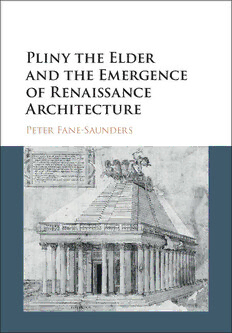
Pliny the Elder and the Emergence of Renaissance Architecture PDF
Preview Pliny the Elder and the Emergence of Renaissance Architecture
Winner of the SAH/Mellon Author Awards of the F a n Society of Architectural Historians e - S a The Naturalis historia by Pliny the Elder provided Renaissance scholars, artists and u n architects with details of ancient architectural practice and long-lost architectural d e Pliny the Elder wonders – material that was often unavailable elsewhere in classical literature. r s Pliny’s descriptions frequently included the dimensions of these buildings, as well as details of their unusual construction materials and ornament. This book and the Emergence o P describes, for the first time, how the passages were interpreted from around 1430 f l i R n to 1580, that is, from Alberti to Palladio. Chapters are arranged chronologically of Renaissance e y within three interrelated sections – antiquarianism; architectural writings; n t drawings and built monuments – thereby making it possible for the reader a h i Architecture to follow the changing attitudes to Pliny over the period. The resulting study s e s E a establishes the Naturalis historia as the single most important literary source after l n d Vitruvius’s De architectura. c e Peter Fane-Saunders e r A a PETER FANE-SAUNDERS currently holds a Leverhulme Trust Early r n Career Fellowship in the Department of Classics and Ancient History at Durham c d h University. He is a specialist in Renaissance art and architecture. His research i t t h analyses how buildings, known only from descriptions in ancient texts, were e e c interpreted by Renaissance scholars, artists and architects. He has delivered papers t E on Renaissance art, architecture and literature at universities in France, Germany, u m r e Italy and the UK. His articles have been published in academic journals in various e r European countries. He was Rome Fellow at the British School at Rome. g e n c e Printed in the United States of America Cover image: Bastiano da Sangallo(?), Perspectival elevation of the Mausoleum at Halicarnassus, U 240Ar, GDSU. Credit: Firenze, GDSU / Su concessione del Ministero dei beni e delle attività culturali e del turismo. PLINY THE ELDER AND THE EMERGENCE OF RENAISSANCE ARCHITECTURE The Naturalis historia by Pliny the Elder provided Renaissance scholars, artists, and architects with details of ancient architectural practice and long-lost architectural wonders – material that was often unavailable else- where in classical literature. Pliny’s descriptions frequently included the dimensionsofthesebuildings,aswellasdetailsoftheirconstructionfabric and ornament. This book describes, for the first time, how these passages wereinterpretedinItalyduringthefifteenthandsixteenthcenturies.Chapters arearrangedchronologicallywithinthreeinterrelatedparts–antiquarianism, architecturalwritings,anddrawingsandbuiltmonuments–therebymakingit possible for the reader to follow the changing attitudes to Pliny over the period. The resulting study establishes that Pliny’s account of architecture was used extensively during the Renaissance. Indeed, the Naturalis historia representedthesinglemostimportantancientliterarysourceonarchitecture afterVitruvius’sDearchitectura. PeterFane-Saundersisaspecialistinthehistoryofartandarchitecture.His mainresearchinterestistheclassicaltradition–particularlythoseaspectsof the visual arts that derive their inspiration from the ancient world. He received his doctorate from the Warburg Institute, London. His articles havebeenpublishedinvariousacademicjournals.HewasRomeFellowat theBritishSchoolatRomeandcurrentlyholdsaLeverhulmeTrustEarly CareerFellowshipattheUniversityofDurham. PLINY THE ELDER AND THE EMERGENCE OF RENAISSANCE ARCHITECTURE PETER FANE-SAUNDERS UniversityofDurham 32AvenueoftheAmericas,NewYork,ny10013-2473,usa CambridgeUniversityPressispartoftheUniversityofCambridge. ItfurtherstheUniversity’smissionbydisseminatingknowledgeinthepursuitof education,learning,andresearchatthehighestinternationallevelsofexcellence. www.cambridge.org Informationonthistitle:www.cambridge.org/9781107079861 ©PeterFane-Saunders2016 Thispublicationisincopyright.Subjecttostatutoryexception andtotheprovisionsofrelevantcollectivelicensingagreements, noreproductionofanypartmaytakeplacewithoutthewritten permissionofCambridgeUniversityPress. Firstpublished2016 PrintedintheUnitedStatesofAmerica AcatalogrecordforthispublicationisavailablefromtheBritishLibrary. LibraryofCongressCataloginginPublicationData Fane-Saunders,Peter,author. PlinytheElderandtheemergenceofRenaissancearchitecture/PeterFane-Saunders. NewYork:CambridgeUniversityPress,2016.|Includesbibliographicalreferencesandindex. LCCN2015040728|ISBN9781107079861(hardback) LCSH:Architecture,Renaissance–Italy–Sources.|Pliny,theElder.Naturalishistoria.|Pliny, theElder–Influence. LCCNA1115.F35201|DDC724/.12–dc23 LCrecordavailableathttp://lccn.loc.gov/2015040728 isbn978-1-107-07986-1Hardback CambridgeUniversityPresshasnoresponsibilityforthepersistenceoraccuracyof URLsforexternalorthird-partyInternetWebsitesreferredtointhispublication anddoesnotguaranteethatanycontentonsuchWebsitesis,orwillremain, accurateorappropriate. IllustrationsinthispublicationwerefundedbyagrantfromtheSAH/MellonAuthorAwardsofthe SocietyofArchitecturalHistorians. ThecostofcolourseparationinthispublicationwasfundedbytheFacultyofArtsandHumanities, UniversityofDurham. For my parents CONTENTS Illustrations page ix EditorialNote xv Acknowledgements xvii Abbreviations xxi 1 INTRODUCTION 1 PLINY THE ELDER AND HIS PLACE IN ANTIQUE AND 11 MEDIAEVAL WRITINGS ON ARCHITECTURE 25 PartI PlinytheElderandAntiquarianStudiesoftheRomanRuins 2 INITIAL EXPLORATIONS: PETRARCH, THE MIRABILIA URBIS ROMAE, AND FLAVIO BIONDO 27 3 THE MANUSCRIPT HUNTER AND THE LIBRARIAN: 46 POGGIO BRACCIOLINI AND GIOVANNI TORTELLI 55 4 A NEW SYSTEM: POMPONIO LETO AND HIS SCHOOL 76 5 EMERGING DOUBTS 91 PartII PlinytheElderandArchitecturalWritings 6 PLINY AND LEON BATTISTA ALBERTI: TWO “ARCHITECTURAL HISTORIES” 93 7 PLINY, FILARETE, AND THE IDEAL PATRON OF 110 ARCHITECTURE 8 “ALDUS AND HIS DREAM BOOK”: THE HYPNEROTOMACHIA POLIPHILI 128 145 9 A MORE DOWN-TO-EARTH PLINY vii viii CONTENTS 10 MIXING THE TRADITIONS: THE CURIOUS CASE OF 170 CESARE CESARIANO 11 DEVELOPMENTS IN THE VENETO: THE VITRUVIAN COMMENTARIES OF DANIELE BARBARO AND I QUATTRO LIBRI BY ANDREA PALLADIO 195 227 PartIII PlinytheElder,ArchitecturalDrawings,andBuiltMonuments 12 STANDING BEFORE THE MARVELS: CIRIACO D’ANCONA AND PLINY’S OPERA MIRABILIA IN TERRIS 229 13 IN THE MIND’S EYE: DRAWINGS OF PLINIAN WONDERS, FROM LEONARDO TO ANTONIO DA 245 SANGALLO THE YOUNGER 14 FROM PAPER TO STONE: REBUILDING PLINY’S 281 ARCHITECTURAL MARVELS FINAL THOUGHTS: PLINY’S INFLUENCE ON THE RENAISSANCE UNDERSTANDING OF ANCIENT 312 ARCHITECTURE Appendices 323 Notes 325 Bibliography 409 Credits 463 Index 465
